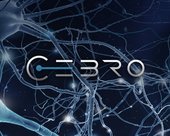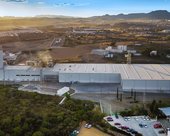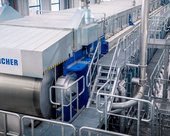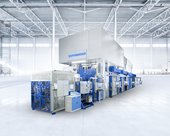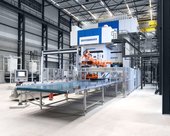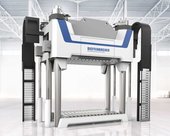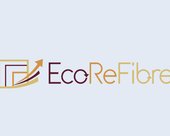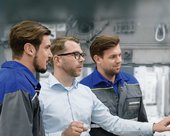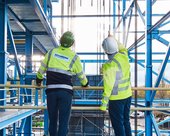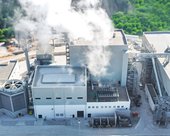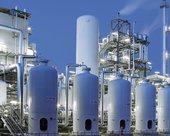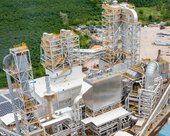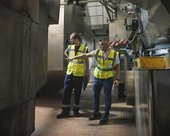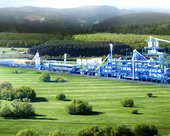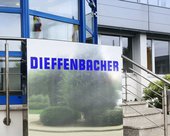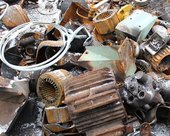Automotive suppliers and others who manufacture composite parts can increase their production by as much as 7% with DIEFFENBACHER’s new, fully automated Fibercut cutting and stacking system featuring a quick-change unit. The Fibercut system enables automated processing of sheet molding compound (SMC) materials.
SMC materials are used by automotive part suppliers to manufacture composite components such as truck bumpers, air deflectors, fenders and trunk lids as well as e-mobility solutions including battery covers and battery boxes. For the logistics and construction industries, SMC technology is used to manufacture pallets, door skins, light wells, switch cabinets and components for rail vehicles. While most SMC applications still rely on error-prone and time-consuming manual processes, DIEFFENBACHER’s fully automated Fibercut SMC cutting and stacking system delivers significantly increased productivity and plant efficiency.
The intelligent Fibercut consists of a cutting unit with a cutting belt, a stacking table and a quick-change unit for SMC on coil or in festoons to further increase productivity. The cutting unit communicates with the stacking gantry or robot and is able to implement complex laying patterns automatically. “Different cutting patterns can be realized at the same time with maximum flexibility. Using an active compensation cut, deviations in the weight of the material stack will be actively corrected. This ensures compliance with weight tolerances and maximum reproducibility even with the geometric complexity of the SMC layer structure,” says Marco Hahn, Director Sales of DIEFFENBACHER’s Forming Business Unit.
The new quick-change unit enormously increases the system’s availability by allowing a complete SMC coil or festoon changeover within a few minutes. Including gripper change stations, the production line can be rapidly switched over to another component. Further, the Fibercut monitors when the SMC material nears an end and notifies the operator. The operator can prepare to change the material without an unplanned stop of the machine. The quick-change unit is equipped with an automated foil removal system to reduce the “on-air time” of the SMC to preserve the styrene for optimal part quality.
“Since the material can be prepared entirely offline and the material change process runs fully automatically, the quick-change unit saves 10-15 minutes per change compared to conventional cutting systems,” explains Hahn. Assuming annual production of 80,000 pieces, SMC consumption of 2 million lbs. per year and 600 related coil changes, output can be increased by 3,000-4,500 parts or 3-5% per year. “Utilizing SMC festoons, the annual output of the production line can be increased even more,” Hahn adds. “As festoons usually contain less SMC material than coils, more changes are needed to achieve the same output per year. The quick-change unit ‘converts’ change time into additional production time, enabling an increase in output of up to 5-7%.”
After the SMC material is unwound from the coil or conveyed out of a festoon fully automatically, it is cut to size as required by automatically engaging longitudinal knives and a crosscutting knife. The position of the longitudinal knives can be adjusted manually for creating different cutting patterns. The material feed takes place by means of a driven mangle roll system: Consistent tension on the material as well as changes in the coil diameter are compensated for by the interaction of a dancer roll system with a controlled roll unwind drive, which ensures uniform material infeed.
The SMC edge trimming removes the dry edges of the SMC material for better part quality and a reduced scrap rate. During cross-cutting, the roller knife is lightly pressed against a “shear block.” This ensures the most precise cuts and delivers a robust cutting process (scissor cutting). It also enables precise compensation cuts. “To reduce maintenance costs, all knives are designed as roller knives. All longitudinal knives operate ‘contactless,’ meaning they run in grooves and have contact only with the material. This increases the service life of the equipment and reduces operating costs,” says Hahn. For maximum flexibility, the Fibercut can be equipped with a customized number of roller knives. During production, the knives can be switched on and off individually to create different cutting patterns.
From the cutting conveyor, the SMC cuts are stacked on a separate stacking table with weighing cells by using a handling robot or gantry to create an individually configurable SMC stack. Inline weight measurement of each cut and the corresponding length correction of the subsequent cut actively compensate for any weight fluctuations in the material. A precise total weight of the final SMC stack is thus guaranteed. A robot then picks up the complete SMC stack off the stacking table and places it into the mold of the press using a corresponding gripper. “The optimized stack weight results in better material flow and cavity filling, which reduces the overall scrap rate. In addition, the Fibercut pre-stacks SMC layers to simplify the stacking process. This reduces the cycle time and increases productivity,” Hahn explains.
The Fibercut has an intuitive and clear visualization to monitor the material infeed for optimized changeover times as well as the stacking process of the SMC batch to control the weights of the cuts or the final SMC stack. The recipe menu helps to keep track of existing projects or parts and saves the cutting patterns. “Operators get a quick and clear overview of the current status of the machine at all times,” says Hahn. “Distinct text messages and a notification archive facilitate troubleshooting,” he adds.
The Fibercut can be used both in a fully or semi-automated production cell and, in an alternative design, even in a manual production setup. In a fully automated production cell, SMC stacking is performed by a stacking robot or gantry. Further, DIEFFENBACHER offers line integration, programming and gripper systems. For use in a manual production setup or semi-automated production cell, the Fibercut is equipped with safety features that allow safe human interaction. Additionally, the Fibercut is available as a “transportable system” that can be used flexibly in different production areas within a building, e.g., for different presses. The footprint of Fibercut is approximately 6,300 mm by 2,800 mm. The cutting belt and stacking table are customizable.
At an open house event at DIEFFENBACHER’s headquarters in Eppingen, Germany, in July 2023, customers saw a live presentation of Fibercut and its benefits. The functionality of the system was demonstrated on a machine that was delivered to a customer directly after the event.
“We have incorporated the feedback and requirements of our long-standing customers into the development of our new Fibercut SMC cutting and stacking system to ensure that it makes an important contribution to the efficient production of composite components, especially, but not only, for e-mobility,” Hahn concludes. “Compared to manual processes, the Fibercut enables shorter cycle times and consistently high component quality. This results in considerably increased productivity and significantly improved plant efficiency.”

